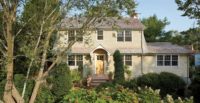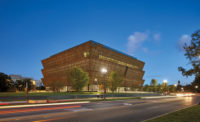In recent years, the District of Columbia Public Library (DCPL) has embarked on a program of building architecturally noteworthy facilities in a variety of Washington neighborhoods. The twofold mission clearly emphasizes the value of books and reading while fostering a sense of community cohesion. Of these districts, Anacostia, once plagued by drugs, crime, and poverty, is particularly ripe for such an ambitious effort.
In selecting the Freelon Group of Durham, North Carolina, in association with R. McGhee & Associates, to design the District of Columbia New Anacostia Neighborhood Library, the client made it clear it wanted an iconic building that would engage the community around it. DCPL didn’t know it at the time (2007), but it selected the architect who would soon be involved in designing another, even more visible, icon: the National Museum of African American History and Culture, where Freelon is working with a team of architects led by David Adjaye and including Davis Brody Bond Aedas and the Smith Group. Interestingly, Adjaye and Davis Brody Bond Aedas are also designing libraries for Washington, and Freelon has just finished the Tenley Friendship Neighborhood Library.
Since the $10.3 million Anacostia library straddles an area that gradually shifts from commercial to residential buildings in the city’s southeast section, Freelon decided to beef up the scale at the entrance with a bright green, perforated bent-metal canopy and a 37-foot-high light tower clad in frosted laminated glass. As visitors arrive at the expansive entrance plaza on Good Hope Road, they readily see the various activities of the library’s main floor though the 17-foot-high glazed window wall.
The idea was to create a library “with both high visibility and transparency of function,” says Jeff Bonvechio, director of 21st Century Capital Projects for DCPL.
Because the grade drops 12 feet toward the back of the one-acre site, Freelon broke up the library’s massing with pavilion-like protrusions. At the rear of the building, a lower-level entrance, dramatically framed by a portal of ground-faced gray concrete masonry and silvery metal panels, gives direct access to a 100-person community meeting room.
In building this 22,000-square-foot library, Freelon had to take into account certain factors. One was the presence of large, old oak trees on the edge of the property. In addition, a temporary library operated on the site during construction, which was to be torn down when the new building was finished. In its place a bioretention basin and a swale now filter storm water before it goes on its way to the Anacostia River.
In organizing the circulation in the library’s efficient plan, Freelon and his team placed a long axial path along the east side of the structure; visitors follow this main street past the circulation desk and conference rooms on one side, with stacks, reading areas, and computer desks extending through the open area to the west. “We let the stacks define the space,” says Freelon, whose arrangement of low metal shelves provides an easy sense of orientation to the users.
The bare-bones structure includes exposed steel columns and ceilings. Raised access floors, 14 inches thick, accommodate the power cables needed for computers plus heating and air-conditioning elements. As Freelon points out, distributing hot and cold air through the floor is more energy-efficient in terms of reaching the occupants than blasting air from above.
The linear skylights overhead and the exposed metal-deck ceiling help expand the sense of height in the one-story space. Admitting so much daylight to the reading room and ancillary areas through the skylights and the windows (shielded by the perforated screens and canopies) helps reduce the building’s electricity needs. To obtain a LEED Silver rating, the architects made use of recycled materials where possible. And, instead of shipping building products from miles away, they went to regional manufacturers for items such as carpet and gypsum board.
All told, the horizontal expanse of taut planes along the front facade, punctuated by the vertical shaft of the light tower, brings to mind the utopian spirit of mid-20th-century Modernist architecture. This syncopated massing in relation to the drop in grade relates the overall design to the site and makes more discrete and intimate the assorted programmatic elements of the structure. On top of this, Freelon’s deployment of inexpensive materials, whether massive (concrete block) or lightweight (metal screen), opaque (metal panel) or transparent (glass), is sophisticated and well thought out. Inside the library, the clarity of plan combined with the daylighting and the interior colors further communicates the intended message: come, meet, and read.
Architect:
The Freelon Group in association with R McGhee & Associates
5310 S. Alston Ave.
Durham, NC 27713
(919) 941-9790
(919) 767-0144
Location: Washington, D.C.
Completion Date: June 2010
Gross square footage: 22,000 sq.ft.
Cost: $10.3 million
|
People Owner Architect Personnel in architect's firm who should receive special credit: Architect of record AND DESIGN ARCHITECT Associate architect(s) Interior designer Engineer(s) Structural engineer: Stewart Engineering Electrical engineer: John J Christie & Associates Civil engineer: Delon Hampton and Associates Geotechnical engineer: Professional Consulting Corporation Consultant(s) Lighting: Horton Lees Brogden Lighting Design Acoustical: Draper Other: EMSI (Energy Modeling) General contractor Photographer(s): CAD system, project management, or other software used |
|
Products Structural system Exterior cladding Metal/glass curtainwall: MR Metals (Metal); JEBerkowitz, LP. (Glass); Concrete: Ernest Maier, Inc. Wood: Columbia Woodworking Inc, 3Form – Resin Panels. (Millwork) EIFS, ACM, or other: Exterior wall backup system: Georgia Pacific-Densglass Exterior Sheathing, Bakor Airbloc – Fluid Applied Weather Membrane Roofing Windows Glazing Skylights: WASCO Windows and doors Wood doors: Eggers Industries, DeLaFontaine Hardware Interior finishes Suspension grid: Armstrong World Industries Inc. Cabinetwork and custom woodwork: Columbia Woodworking Paints and stains: ICI Paints Wallcoverings: Onix Mosaico, Aarco Products Inc. Paneling: Cladding: Metecno-Morin Coporation-Metal Wall Panels Plastic laminate: Formica, White Sculpted; Pionite, Surfin USA Special surfacing: Davis Colors-Colored Concrete Floor and wall tile: Onix Mosaico, Recycled StoneGlass, Aarco Products Inc. (restroom wall tile) Resilient flooring: Armstrong World Industries Inc-Bio-based Tile Carpet: Shaw Industries Inc Raised flooring: Haworth Tec-Crete Access Flooring. Furnishings Reception furniture: Harter, Anthro KB Chair Fixed seating: Tables: Bernhardt, Edge; Herman Miller, Nelson; KI, Barron Upholstery: Architex, Bonnie Sprout; Momentum, Max Fizz Other furniture: Bernhardt, b.2 Lounge Chair, Fly Bench; Stylex, Paz Lounge Chair Lighting Lighting: Sistemalux, Pace, Spring City, Hydrel, Lightolier, Prudential, Selux Conveyance Plumbing Add any additional building components or special equipment that made a significant contribution to this project: Renewable energy systems (excluding photovolatics): Solar Skies – Solar Hot Water Heater Adhesives, coatings and sealants: Pecora, Dow HVAC: York, Johnson Controls, Titus, A.O. Smith Insulation: John Manville-Batt Insulation, Dow Thermax–Rigid Insulation. Site and landscape products: HessAmerica, Concord Industries. |













Post a comment to this article
Report Abusive Comment